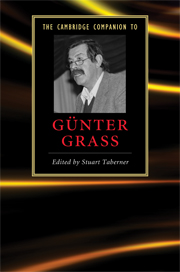Book contents
- Frontmatter
- Introduction
- 1 Biography as politics
- 2 Günter Grass’s political rhetoric
- 3 The exploratory fictions of Günter Grass
- 4 Günter Grass and magical realism
- 5 Günter Grass’s ‘Danzig Quintet’
- 6 Günter Grass and gender
- 7 Authorial construction in From the Diary of a Snail and The Meeting at Telgte
- 8 Günter Grass’s apocalyptic visions
- 9 Günter Grass and German unification
- 10 Günter Grass’s Peeling the Onion
- 11 Günter Grass as poet
- 12 Günter Grass and art
- 13 Günter Grass as dramatist
- 14 Film adaptations of Günter Grass’s prose work
- 15 Günter Grass and his contemporaries in East and West
- Guide to further reading
- Index
12 - Günter Grass and art
Published online by Cambridge University Press: 28 January 2010
- Frontmatter
- Introduction
- 1 Biography as politics
- 2 Günter Grass’s political rhetoric
- 3 The exploratory fictions of Günter Grass
- 4 Günter Grass and magical realism
- 5 Günter Grass’s ‘Danzig Quintet’
- 6 Günter Grass and gender
- 7 Authorial construction in From the Diary of a Snail and The Meeting at Telgte
- 8 Günter Grass’s apocalyptic visions
- 9 Günter Grass and German unification
- 10 Günter Grass’s Peeling the Onion
- 11 Günter Grass as poet
- 12 Günter Grass and art
- 13 Günter Grass as dramatist
- 14 Film adaptations of Günter Grass’s prose work
- 15 Günter Grass and his contemporaries in East and West
- Guide to further reading
- Index
Summary
Looking back to his childhood in his memoir Peeling the Onion (2006), Günter Grass told of the niche in his parent's apartment reserved for him: 'There a shelf held modeling clay, poster paints and a sketch pad'. He further observed 'I lived through pictures . . .' (O, p. 6), explaining that he collected coupons dispensed in cigarette packs with which he acquired reproductions of master paintings by Dürer, Botticelli and the like, pictures he mounted in albums provided by the tobacco company. His mother quizzed him on the images and the child proved himself adept in being able to distinguish one painter, one style from another. The pastime sharpened his boyhood imagination. Grass went on to relate how this early interest in art history was accompanied by the ability to sketch and paint, an inborn skill he considered to have been inherited from an uncle (O, p. 50). These talents came into play as a sixteen-year-old paramilitary recruit, when he was ordered to decorate the unit's mess hall with paintings (O, pp. 81-2). After induction into active duty, he was interviewed for leadership training. He regaled his amazed interlocutor with his knowledge of art history and was promptly turned down for the special assignment (O, pp. 115-16) - such interests were hardly deemed crucial to final victory (Endsieg).
- Type
- Chapter
- Information
- The Cambridge Companion to Günter Grass , pp. 166 - 179Publisher: Cambridge University PressPrint publication year: 2009
- 2
- Cited by

